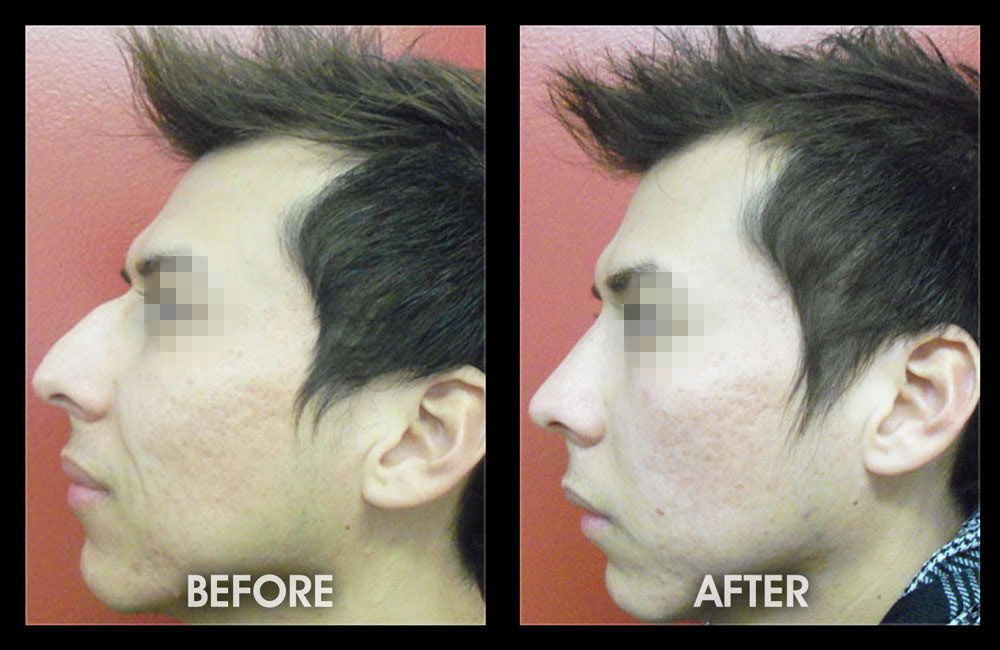RHINOPLASTY – LOS ANGELES
Plastic Surgery for Men. Everything you need to know about Rhinoplasty Procedures.
The procedure known as rhinoplasty (sometimes known as “nose sculpting surgery”) helps to alter the shape of the nose. The boney and cartilaginous components of the nose help give it shape and structure. To create a more aesthetically pleasing nose, these can be changed.
The majority of surgeons use an incision in the columella to carry out this sort of surgery (the tissue that separates the nostrils). The open approach to rhinoplasty is what is known as this. Unfortunately, if inadequate healing takes place or the incision line heals with a darker pigmentation, this may leave an ugly scar. For this reason, Dr. Nikolas Chugay’s closed rhinoplasty treatment is in high demand. Many surgeons in South and Central America use this procedure, which depends on incisions inside the nose to give outstanding cosmetic results WITHOUT EXTERNAL SCARRING.
SECONDARY RHINOPLASTY/REVISION
Patients who have previously had rhinoplasty surgery could experience difficulties following their initial procedure or need additional improvement or correction following a preliminary procedure. To assist address any problems they may still have, these patients can get secondary or revision rhinoplasty. Revision rhinoplasty is far more difficult than primary (first time) rhinoplasty and calls for an aesthetics-focused surgeon. Dr. Nikolas Chugay can help you further mould your nose to the dimensions you may be wanting by employing his skills in nasal treatments. He has completed thousands of primary and revision rhinoplasty surgeries.
In some instances of secondary cosmetic and reconstructive rhinoplasty, Dr. Chugay employs soft nasal implants. In these situations, the nasal bridge may be augmented or concave deformities, which are frequently seen in asymmetrical, damaged, or deformed noses, may be filled in. In contrast to cartilage grafts, other natural or artificial implants, or fillers, these nasal implants offer a natural-looking nose and smooth contours.
SEVERE NASAL DEFORMITY RECONSTRUCTION
It is frequently possible to straighten crooked noses by correcting septal abnormalities. Rarely is a conservative reduction of the majority of the septum necessary to effectively correct a significantly deviated nose. A fundamental advancement in rhinoplasty technique, the removal of the septal cartilage (the inner barrier between the nostrils) enables the repair of nasal abnormalities that were previously regarded to be uncorrectable. However, this septal reduction surgery for nose shaping keeps the tip support. This method has gained popularity thanks to Dr. Chugay in the United States and Dr. Jose Juri in Argentina.
Who ought to perform secondary or reconstructive rhinoplasty?
Only a small number of exceptionally experienced surgeons are capable of performing successful reconstructive or secondary rhinoplasty (nose sculpting surgery). Verify the experience in these surgeries of your surgeon.
Where is the operation done?
The procedure will be carried out as an outpatient procedure in our fully accredited surgical facility. No hospitalisation is necessary.
Risks
There are hazards associated with nose surgery. Infection, bleeding, scarring, nasal deformity, numbness in and around the nose, breathing difficulties, and the potential need for more treatments are just a few of the potential hazards.
Following Surgery
The nose will be put in a cast after the procedure to protect the area from external harm as it heals. On your post-operative visit, the cast will be taken off. Breathing may be challenging after surgery due to swelling; however, as the swelling goes down, you should feel a significant improvement in breathing comfort.


